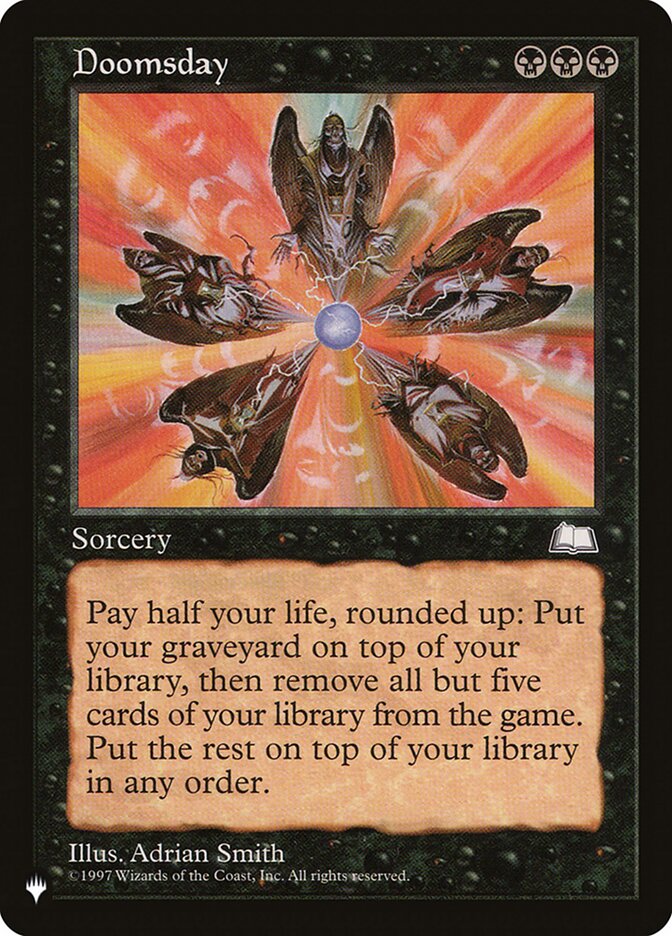Hello everyone! I’m Daniele Scaduto, a passionate Magic player focusing on the Legacy and Centurion formats.
I owe all my knowledge to the fortune of meeting and receiving guidance and teachings from Luca Fasoli, one of the best Italian Magic players with the card Doomsday. Today, in this collaboratively written primer, we aim to explain the potential and functionality of this commander, which is highly explored and played in the current Centurion scene but, fortunately, not in the “Fasolian” version. Instead, we use a game plan that focuses entirely on the reanimator strategy.

Our approach is fundamentally different, a combo plan that leverages the magical lines of Doomsday, a sorcery with a cost of three specific black mana that halves our life total (rounded up) in exchange for selecting 5 cards (from our library and graveyard) that become our new deck, with the rest of the cards being exiled.
“Many write phrases in rhyme, few of those become poetry.”.
You can find us on Moxfield as Fuz65 and DaniScadu and this is the list we are currently playing. Enjoy the read!

First, let’s analyze the abilities of Vohar, Vodalian Desecrator:
- The first instance is an activated ability that lets us draw a card and discard another. If the discarded card is an instant or sorcery, Vohar, Vodalian Desecrator grants us one life while making our opponent lose one life.
- The second instance is another activated ability that costs two generic mana and can only be used at sorcery speed. It allows us to sacrifice Vohar, Vodalian Desecrator to recast an instant or sorcery from our graveyard, which is then exiled after use.
These two abilities can sometimes synergize with our plan but should be analyzed individually. Both offer interesting and useful advantages for executing our game plan.
Drawing and discarding helps filter the deck, allowing us to get rid of potentially suboptimal cards in specific situations and find better ones.
The second ability lets us reconsider a resource in the graveyard, giving us the chance to reuse it. The cantrip mechanic is fundamental for finding victory through Doomsday and Vohar, Vodalian Desecrator. In this case, the draw-and-discard capability will allow us an almost free entry into the five-card stack.
Currently, there are no better commanders to facilitate this plan, although Rona, Herald of Invasion is a viable variant, introducing a series of combos based on Mox Amber (see Matteo Gulmini’s list).
What exactly does this deck do?
We are talking about a control-combo deck with a good capacity for interaction thanks to counters, discards, and removals. It is versatile enough to direct and manage the game according to the needs of the situation to find the Doomsday card, having already meticulously planned its use.
Deck structure
Planeswalker
Jace, Wielder of Mysteries, the Centurion projection of Thassa’s Oracle, is our win condition. Thanks to its static ability and the +1 activation, it will allow us, after resolving Doomsday, to win the game.
Creatures
The creature section boasts four types of effects impacting our game: cantrip, graveyard recursion, bouncing, and tutor.
More specifically, cards like Baleful Strix, Street Wraith, Psychic Frog, and Jace, Vryn’s Prodigy expand our card-drawing capabilities. The latter, when flipped, pairs with Snapcaster Mage to enable recursion from the graveyard for instants and sorceries.
Brazen Borrower is an excellent solution for situations where some permanents might block or slow down our combo plan.
Lastly, Drift of Phantasms becomes an optimal tutor for cards with a converted mana cost of three due to its transmute ability. It also serves as an effective flying blocker.
Sorceries and Instants
These make up exactly 50% of the deck.
We analyze these two types of cards together because they fall into five macro groups. For each, we included the cards that ensure the best balance of cost, efficiency, and synergy. The five groups are:
- Tutors, starting with the classics like Profane Tutor, Personal Tutor, and Grim Tutor. The shell also includes Perplex due to its transmute ability.
- Counters, emphasizing those that can be played without paying their mana cost, such as Pact of Negation.
- Removals, typically low-cost to buy us time for our plan or remove creatures with particularly annoying abilities.
- Cantrips, the heart of the deck, crucial for advancing our plan and ensuring a protected finish.
- Discards, useful for preemptively countering potential threats and gaining important information about the opponent’s hand in relation to our plan.
Additionally, there are two rituals that provide black mana, Dark Ritual and Cabal Ritual, and an alternative way to close through Doomsday with Demonic Consultation. When played well, this last card allows for a victory with Jace, Wielder of Mysteries on the field.
Artifacts
The artifacts in the list are strictly essential for the plan. We have Lion’s Eye Diamond, crucial in about 70% of the five-card piles we create with Doomsday. Lotus Petal is a useful little stone providing extra mana with no investment on our part. Lastly, The One Ring is very strong for the cantrip mechanic and helps protect us from our opponents.
Enchantments
The only enchantment currently used is Necropotence. It allows us to lose life points for each card we decide to exile temporarily from the top of our deck. At the beginning of our discard phase, these cards will be added to our hand.
Depending on our life points, Necropotence offers the possibility, if well used, to build an ideal hand for a finishing move.
Lands
For this archetype, we play around 36 lands. It is important to highlight that for our plan, some cards like Gush require the presence of two Islands, and Doomsday itself requires triple black mana. Therefore, we use more basic lands compared to other archetypes. We also use mediocre lands with the Island subtype (Sunken Hollow and Fetid Pools), which are typically not favored in high-powered decks.
Some words can be spent in favor of Lake of the Dead, a land that, upon entering, requires the sacrifice of a Swamp to stay in play and can further sacrifice a Swamp to add four black mana. It’s a delicate land, often seen not as a regular land but as a ritual to add mana. When played at the right time, it allows for the momentary acquisition of six black mana, a notable boost for the deck’s plan.
Gameplan
Despite its low cost, Vohar, Vodalian Desecrator is not a commander to be overused. The game plan must not exclusively depend on our commander. The deck can and should play effectively even without him on the board.
Our plan involves resolving Doomsday, and from there, building a five-card pile usually composed of Gush, Gitaxian Probe, Lion’s Eye Diamond, Jace, Wielder of Mysteries and another card.




If we have Vohar, Vodalian Desecrator on the field or another way to draw a card, we proceed to enter the pile, where we find Gush, a double cantrip potentially at no mana cost if two Islands are returned to hand. Thanks to it, we get Lion’s Eye Diamond and Gitaxian Probe in hand. We play the Diamond and then the Probe, crucially maintaining priority by responding with the Diamond’s sacrifice to draw Jace, Wielder of Mysteries with three blue mana in the pool. We play Jace and activate his ability to mill the last card and attempt to draw from the now-empty deck for the win.
From this explanation alone, significant considerations arise that a player must necessarily take into account for this combo plan. Three sources of black mana and a small number of life points are needed to play Doomsday, two Islands for Gush (substitutable by Night’s Whisper as a double cantrip, though not free in terms of mana investment), and numerous interactions that could completely ruin our plan, such as mill cards, counters, and specific interactions with Jace, Wielder of Mysteries like removals or bounce effects, or cards like Endurance with an especially disruptive ETB for our plan. For these reasons, the plan must be carefully thought out in every detail, leaving nothing unchecked, as the price of failure would be immediate defeat. This is precisely where the skills of players who approach the Doomsday plan are tested.
Matchups and weak points
lThe deck has a solid structure that allows it to handle almost all current meta matchups respectably. For aggro matchups, they are not particularly unfavorable. Choosing the right opening hand is crucial. A turbo start can be a good choice but is unfortunately very rare. More likely is finding a hand with excellent, low-cost mana answers to buy time and manage our closing plan around turn four or five.
For control or midrange matchups, our gameplay will significantly depend on the presence of blue in the opponent’s deck colors, as it implies a higher number of interactions with our plan. Therefore, it is important to consider extending the timeframe strategically to achieve our goal. It is vital to have resources that give us the maximum clarity on the opponent’s situation, enabling us to diligently plan the right moment to make our moves or at least respond to multiple interactions in the stack. Currently, Tivit, Seller of Secrets, Oloro, Ageless Ascetic, and Atraxa, Grand Unifier represent sufficiently challenging matchups, but not impossible. Challenging to play, but favorable in the long run, our situation will potentially be smoother and more proactive. If no clock is imposed on us, a way will eventually be found.
Our biggest difficulties come from facing tempo decks like the classic Geist of Saint Traft, Ghyrson Starn, Kelermorph, the newcomer Eris, Roar of the Storm, and in some ways Niv-Mizzet, Parun. By definition, due to their resource pool to manage the opponent’s plan and the pressure exerted by their board states, it becomes complicated to manage both an oppressive board and interactions with our plays using the resources in our shell. Therefore, against proactive decks, the priority will be to manage the situation as much as possible by slowing the opponent’s plan to reach ours, while against reactive decks, we will need to measure threats to uncover the solutions available to our opponents and effectively maneuver around them.
Conclusions
The deck is undoubtedly fun and interactive but also quite complex; we will have to think far ahead in the game (feeling like chess players!) to both prepare the ground for an efficient finish and stay alive.
We hope this article helps readers better understand the deck’s structure, the peculiarities of this commander, but most importantly, the wonder of playing Doomsday.
Written by
Daniele Scaduto, Luca Fasoli














